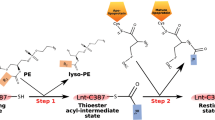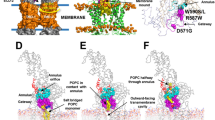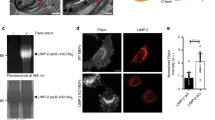Abstract
APOLIPOPROTEIN B (apo B) is crucial for the transport of cholesterol in humans. It is a large secretory protein that mediates the uptake of low-density lipoproteins and renders several forms of lipid droplets soluble in the blood1–3. The binding of lipid by apo B also prevents this hydrophobic protein from precipitating in aqueous solution4. In the endoplasmic reticulum, nascent secretory proteins must be translocated through an aqueous channel in the membrane into the aqueous lumen5, so some novel form of processing may be necessary to maintain the solubility of apo B during its translocation. We have discovered that the biogenesis of apo B in cell-free systems does indeed involve a new variation on protein translocation: unlike typical secretory proteins, apo B is synthesized as a series of transmembrane chains with large cytoplasmic domains and progressively longer amino-terminal regions that are protected against added proteases during the translocation process. In contrast to typical transmembrane proteins, these transmembrane chains are not integrated into the bilayer. Moreover, the transmembrane chains with the shortest protected domains are precursors of forms whose protection is progressively extended to cover the length of the protein. This stepwise conversion occurs post-translationally for the most part. We propose a model on the basis of these findings for the biogenesis of apo B.
This is a preview of subscription content, access via your institution
Access options
Subscribe to this journal
Receive 51 print issues and online access
$199.00 per year
only $3.90 per issue
Buy this article
- Purchase on Springer Link
- Instant access to full article PDF
Prices may be subject to local taxes which are calculated during checkout
Similar content being viewed by others
References
Brown, M. S. & Goldstein, J. L. Science 232, 34–47 (1986).
Scott, J. Molec. biol. Med. 6, 65–80 (1989).
Kane, J. P. A. Rev. Physiol. 45, 637–650 (1986).
Fisher, W. R. & Schumaker, V. N. Meth. Enzym. 128, 247–262 (1986).
Gilmore, R. & Blobel, G. Cell 42, 497–505 (1985).
Borchardt R. A. & Davis R. A. J. biol. Chem. 262, 16394–16402 (1987).
Glickman, R. M. Rogers, M. & Glickman, J. N. Proc. natn. Acad. Sci. U.S.A. 83, 5296–5300 (1986).
Chen, S. H. et al. Science 238, 363–366 (1987).
Young, S. G., Bertics, S. J., Curtiss, L. K. & Witztum, J. L. J. clin. Invest. 79, 1831–1841 (1987).
Knott, T. J. et al. Nature 323, 734–738 (1986).
Yang, C. Y. et al. Nature 323, 738–742 (1986).
Rothman, R. E., Andrews, D. W., Calayag, C. & Lingappa, V. R. J. biol. Chem. 263, 10470–10480 (1988).
Fujiki, Y., Hubbard, A. L., Fowler, S. & Lazarow, P. B. J. Cell Biol. 93, 97–102 (1982).
Perara, E. & Lingappa, V. R. in Protein Transfer and Organelle Biogenesis eds Das, R. C. & Robbins, P. W. 3–51 (Academic, New York, 1988).
Siegal, V. & Walter, P. Cell 52, 39–45 (1988).
Olofsson, S. O. et al. Atherosclerosis 68, 1–17 (1987).
Bostrum, K. et al. J. biol Chem 263, 4434–4442 (1988).
Bamberger, M. J. & Lane, M. D. J. biol. Chem. 263, 11868–11878 (1988).
Pullinger, C. R. et al. J. Lipid Res. 30, 1065–1077 (1989).
Lippincott-Schwartz, J., Bonifacino, J. S., Yuan, L. C. & Klausner, R. D. Cell 54, 209–216 (1988).
Amara, J. F., Lederkremer, G. & Lodish, H. F. J. Cell Biol. 109, 3315–3324 (1989).
Blobel, G. Proc. natn. Acad. Sci. U.S.A. 77, 1496–1500 (1980).
Erickson, A. & Blobel, G. Meth. Enzym. 96, 38–42 (1983).
Melton, D. Nucleic Acids Res. 12, 7035–7056 (1984).
Perara, E. & Lingappa, V. R. J. Cell Biol. 101, 2292–2301 (1985).
Author information
Authors and Affiliations
Rights and permissions
About this article
Cite this article
Chuck, S., Yao, Z., Blackhart, B. et al. New variation on the translocation of proteins during early biogenesis of apolipoprotein B. Nature 346, 382–385 (1990). https://doi.org/10.1038/346382a0
Received:
Accepted:
Issue Date:
DOI: https://doi.org/10.1038/346382a0
This article is cited by
-
Membrane association of the C-terminal half of the open reading frame 1a protein of lactate dehydrogenase-elevating virus
Archives of Virology (1996)
-
Apolipoprotein B intermediates
Nature (1992)
-
Apolipoprotein B intermediates
Nature (1992)
-
Cotranslocational insertion of apolipoprotein B into the inner leaflet of the endoplasmic reticulum
Nature (1991)
-
Control of protein topology at the endoplasmic reticulum
Cell Biophysics (1991)
Comments
By submitting a comment you agree to abide by our Terms and Community Guidelines. If you find something abusive or that does not comply with our terms or guidelines please flag it as inappropriate.



